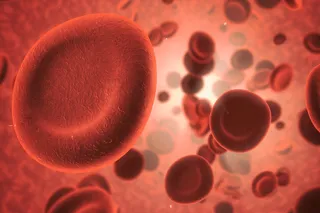With millions of cases per year in the United States, strep throat is an extremely common disease. You might recognize it from a distinctively unpleasant scratchy feeling in the throat, or as the source of many sick days from school for young children.
But there’s still no vaccine for this bacterial infection, mainly because antibiotics can provide an effective treatment. With outbreaks of severe strep throat infections on the rise worldwide — particularly in countries with limited access to antibiotic treatments — medical experts are urging more research on developing a vaccine.
Beyond that, a recent report from the Center for Disease Control and Prevention showed that the rates of both mild and severe strep throat infections reached a 20-year high in 2023. Amid ongoing research, here’s how to identify key signs of strep throat — and what to know about the search for a vaccine.
What Is Strep Throat?
Strep throat, also called streptococcal pharyngitis, is caused by infection with a type of bacteria known as Group A Streptococcus (GAS). Pharyngitis — the scientific name for a sore throat — is one of the most common reasons for physician visits in the United States, and GAS is the most common cause of acute cases.
Read More: 6 Respiratory Illnesses That Could Mean Trouble for Your Lungs
According to the National Institute of Health, GAS causes about 5 to 15 percent of all adult cases of severe sore throat, and nearly 20 to 30 percent of pediatric cases.
Common Symptoms of Strep Throat
Some of the telltale signs of an oncoming case of strep throat include throat pain, fever, headaches, and chills. Infected individuals might feel pain while swallowing, or notice swollen tonsils or lymph nodes.
Because GAS infections share similar symptoms with many other bacterial infections, medical experts say it can sometimes be tricky to diagnose a strep throat infection. However, symptoms such as coughing, a runny nose or pink eye are not signs of strep throat, even though they’re commonly confused for GAS symptoms.
In general, if you’re feeling severe throat pain, the best way to determine whether or not you have strep throat is to visit a medical professional. Healthcare providers can conduct two different types of test for strep throat — a rapid strep test, which involves quickly swabbing the back of the throat, or a throat culture, which allows time to see whether GAS bacteria will grow from a throat swab.
While the throat culture has a slower turnaround time than the rapid strep test, the Center for Disease Control and Prevention says throat cultures can sometimes pick up on GAS infections that a rapid test might miss.
Is Strep Throat Contagious?
Strep throat is a highly contagious disease that spreads primarily through close contact with infected individuals. GAS bacteria spread through saliva, so it’s important to avoid coughing or sneezing in close proximity to others if you’re infected.
Read More: Does a Runny Nose Mean You Have COVID-19, the Flu, or a Common Cold?
Recently, researchers have revealed that GAS bacteria can spread in additional ways, according to a review of literature published in the journal Systematic Reviews in 2021. Other methods of spreading strep throat can include nasal secretions, airborne particles like dust, skin-to-skin contact and touching surfaces or objects that infected individuals have touched. GAS bacteria can even be carried from person to person by insects.
Strep throat has a typical incubation period of two to five days, meaning that you might not notice symptoms immediately after being exposed to GAS bacteria. However, individuals who aren’t symptomatic yet can still spread the disease, the 2021 literature review found.
Strep Throat Prevention and Treatment
There are many simple habits that can prevent the spread of strep throat, from regularly washing your hands to covering your mouth when you cough or sneeze. Because the infection primarily spreads through respiratory droplets, it’s important to stop this from happening, particularly during the winter months when strep throat cases are often the highest.
Other preventative measures include washing dishes or utensils after they’ve been used by a sick person, not sharing food or beverages, and using hand sanitizer whenever possible.
Despite being one of the most widespread and highly contagious diseases, there is currently no known vaccine for strep throat. The most common form of treatment for infected individuals is to take antibiotics, such as penicillin.
A Breakthrough in Prevention: The GAS Vaccine Study
Yet according to a new study, a hypothetical GAS vaccine could greatly reduce the need for antibiotic prescription. The literature review, published in the journal eBioMedicine in 2023, examined 101 studies conducted in 38 countries on antibiotic prescription rates for sore throats.
Read More: How Long Does A Cold Last and How to Get Rid of One Fast
Nearly 37 million courses of antibiotics are prescribed each year to treat sore throats, according to the study authors, about half of which go toward treating GAS. However, if a vaccine is introduced at about 80 percent effectiveness, the analysis found, it could reduce the number of antibiotics prescribed by anywhere from 2.5 to 7.5 million rounds of treatment.
While a course of penicillin or other antibiotics can get rid of a case of strep throat within three to five days, according to the American Academy of Family Physicians, excessive antibiotic prescriptions can lead to antimicrobial resistance — a phenomenon seen when bacteria build up resistance to certain antibiotics with frequent use.
Notably, as our immune systems adapt to antibiotic treatment, it can make common treatments less effective, leading to more and more prescriptions and a higher cost of treatment overall.
The Cost of Treating Strep Throat
In a 2008 study, researchers estimated the annual cost of treating children with strep throat to be somewhere between $224 and $539 million. As antimicrobial resistance grows, experts say, this cost could continue to rise. A cost-effective implementation strategy for a GAS vaccine, by contrast, could cost just a few hundred dollars per person in most countries.
Many healthcare providers also use precautionary prescriptions, giving patients antibiotics to treat sore throats even when their infection is not caused by GAS. This practice, while understandable, could fuel higher rates of antimicrobial resistance by unnecessarily exposing patients to more antibiotics, the eBioMedicine study says.
While the study authors cite a baseline antibiotic reduction of 2.5 million annual treatment courses, coupling vaccine implementation with a decrease in precautionary prescribing could help global healthcare providers reach the maximum projected reduction of 7.5 million annual courses.
What's the Current Status of a Strep Throat Vaccine?
Amid growing concern regarding antimicrobial resistance, funding and support for research on a GAS vaccine has increased significantly over the past several years.
As of 2023, two different vaccines had been tested in clinical trials, with one more scheduled to begin clinical trials at the end of 2023. Several others are currently being tested on rodents and rabbits.
Read More: How Neoantigen Vaccines Keep Cancer From Coming Back
Though a vaccine still hasn’t been approved for widespread use, this recent uptick in research could mean that a vaccine for strep throat and other GAS diseases could become a reality in the not-so-distant future.
Article Sources
Our writers at Discovermagazine.com use peer-reviewed studies and high-quality sources for our articles, and our editors review for scientific accuracy and editorial standards. Review the sources used below for this article:
World Health Organization. Increased incidence of scarlet fever and invasive Group A Streptococcus infection - multi-country
Center for Disease Control and Preventions. Group A Strep Activity
National Library of Medicine. Streptococcal Pharyngitis
Center for Disease Control and Prevention. Strep Throat: All You Need to Know
Systematic Reviews. Modes of transmission and attack rates of group A Streptococcal infection: a protocol for a systematic review and meta-analysis
American Family Physician. Strep Throat
Pediatrics. Burden and economic cost of group A streptococcal pharyngitis
npj Vaccine. Update on the development of Group A Streptococcus vaccines














